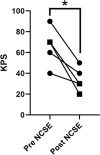Nonconvulsive status epilepticus characteristics in glioma patients: a retrospective study
- PMID: 36881187
- PMCID: PMC9992690
- DOI: 10.1007/s12672-023-00632-3
Nonconvulsive status epilepticus characteristics in glioma patients: a retrospective study
Abstract
Purpose: Epilepsy is a common complication of gliomas. The diagnosis of nonconvulsive status epilepticus (NCSE) is challenging because it causes impaired consciousness and mimics glioma progression. NCSE complication rate in the general brain tumor patient population is approximately 2%. However, there are no reports focusing on NCSE in glioma patient population. This study aimed to reveal the epidemiology and features of NCSE in glioma patients to enable appropriate diagnosis.
Methods: We enrolled 108 consecutive glioma patients (45 female, 63 male) who underwent their first surgery between April 2013 and May 2019 at our institution. We retrospectively investigated glioma patients diagnosed with tumor-related epilepsy (TRE) or NCSE to explore disease frequency of TRE/NCSE and patient background. NCSE treatment approaches and Karnofsky Performance Status Scale (KPS) changes following NCSE were surveyed. NCSE diagnosis was confirmed using the modified Salzburg Consensus Criteria (mSCC).
Results: Sixty-one out of 108 glioma patients experienced TRE (56%), and five (4.6%) were diagnosed with NCSE (2 female, 3 male; mean age, 57 years old; WHO grade II 1, grade III 2, grade IV 2). All NCSE cases were controlled by stage 2 status epilepticus treatment as recommended in the Clinical Practice Guidelines for Epilepsy by the Japan Epilepsy Society. The KPS score significantly decreased after NCSE.
Conclusion: Higher prevalence of NCSE in glioma patients was observed. The KPS score significantly decreased after NCSE. Actively taking electroencephalograms analyzed by mSCC may facilitate accurate NCSE diagnosis and improve the activities of daily living in glioma patients.
Keywords: Epilepsy; Glioma; Modified Salzburg Consensus Criteria (mSCC); Nonconvulsive status epilepticus (NCSE).
© 2023. The Author(s).
Conflict of interest statement
The authors have no relevant financial or non-financial interests to disclose.
Figures


References
-
- Wen PY, Weller M, Lee EQ, Alexander BM, Barnholtz-Sloan JS, Barthel FP, Batchelor TT, Bindra RS, Chang SM, Chiocca EA, Cloughesy TF, DeGroot JF, Galanis E, Gilbert MR, Hegi ME, Horbinski C, Huang RY, Lassman AB, Le Rhun E, Lim M, Mehta MP, Mellinghoff IK, Minniti G, Nathanson D, Platten M, Preusser M, Roth P, Sanson M, Schiff D, Short SC, Taphoorn MJB, Tonn JC, Tsang J, Verhaak RGW, von Deimling A, Wick W, Zadeh G, Reardon DA, Aldape KD, van den Bent MJ. Glioblastoma in adults: a Society for Neuro-Oncology (SNO) and European Society of Neuro-Oncology (EANO) consensus review on current management and future directions. Neuro Oncol. 2020;22(8):1073–1113. doi: 10.1093/neuonc/noaa106. - DOI - PMC - PubMed
LinkOut - more resources
Full Text Sources
Miscellaneous
